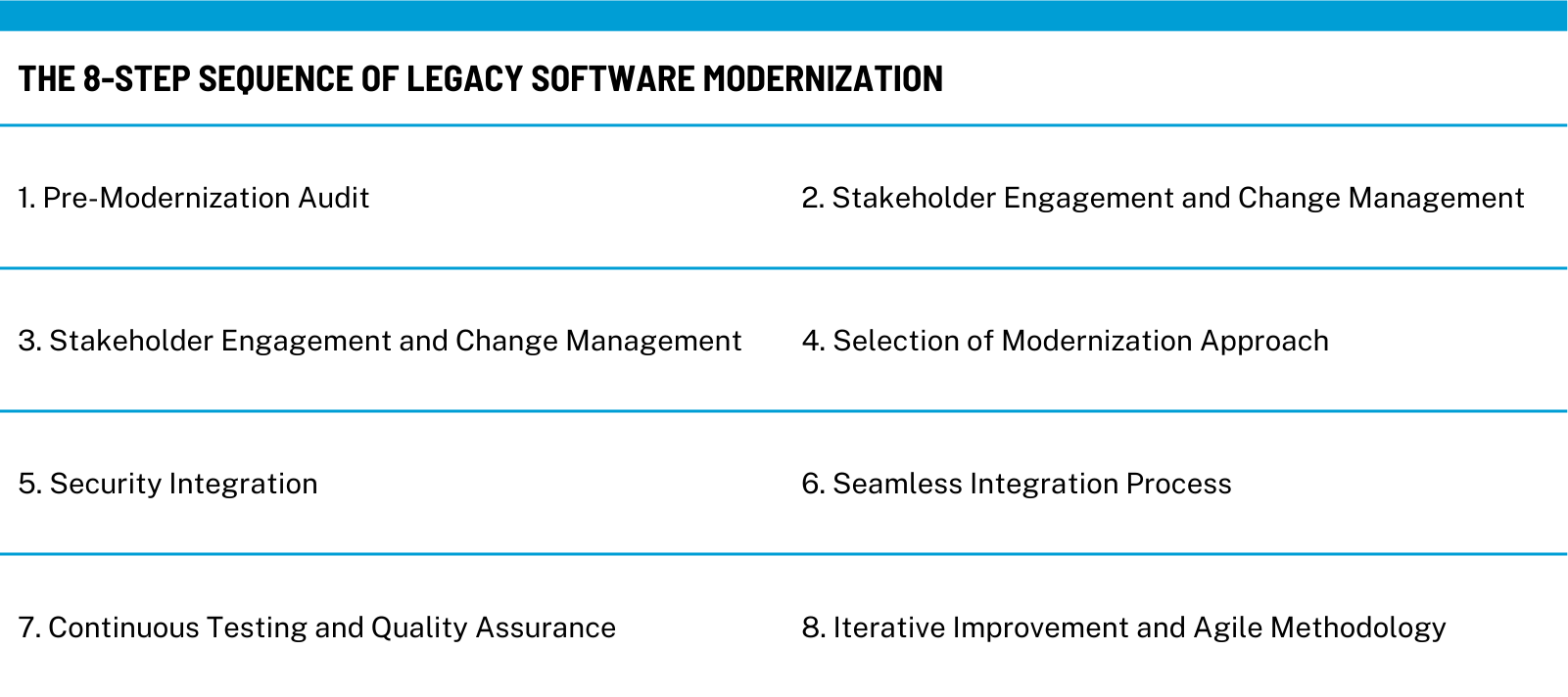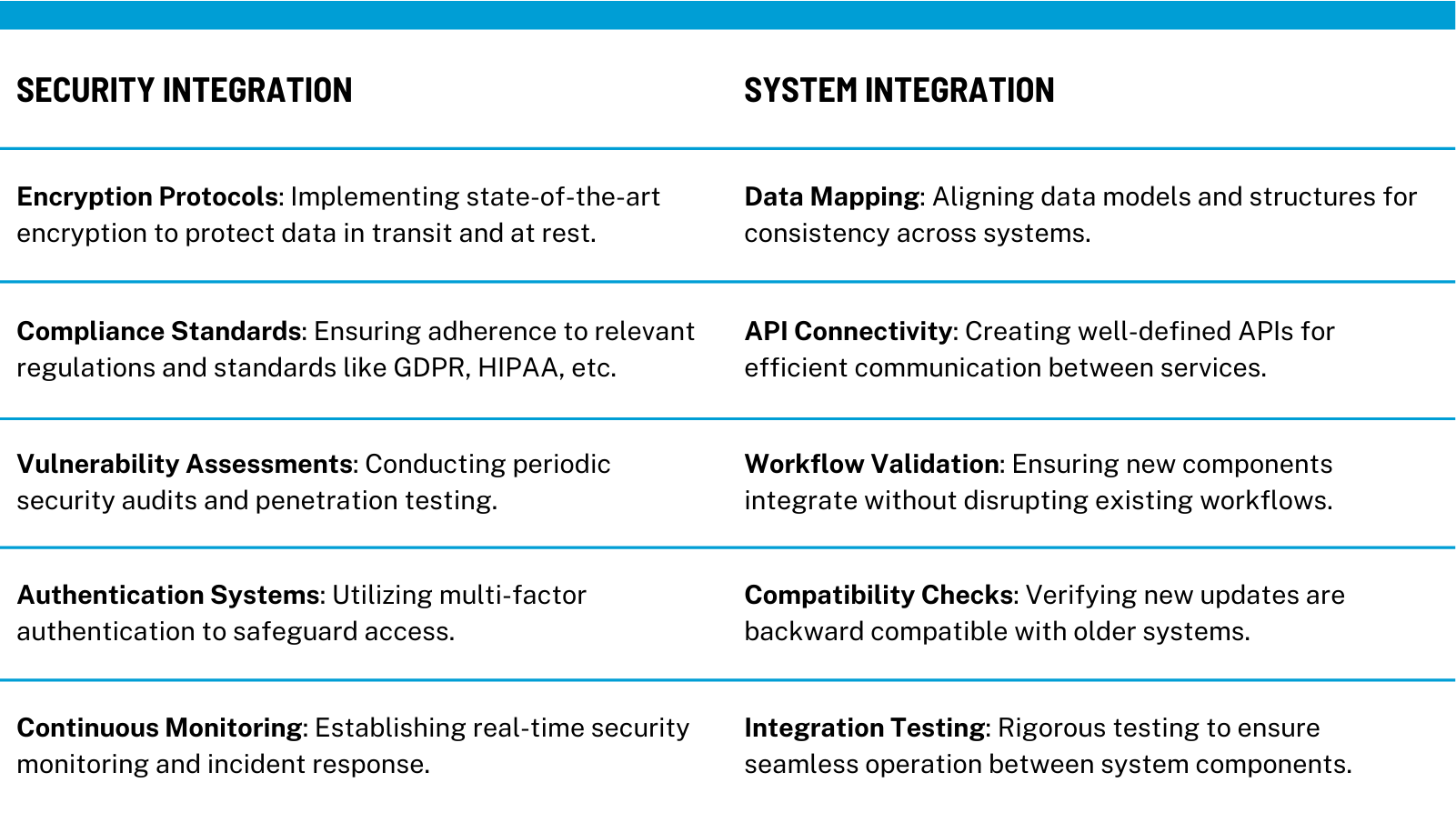The technological infrastructure of any business must evolve to keep pace with the changing demands of the industry. Legacy Software Modernization (LSM) is a critical process that enables organizations to align outdated systems with contemporary operational needs, security standards, and competitive market practices. This process is not solely an IT endeavor but a strategic initiative that positions a business for resilience and growth.
This article explores the essential best practices for LSM, offering a framework that organizations can adopt to navigate the complexities of modernization effectively. By applying these practices, companies can aim to reduce risks, enhance return on investment, and ensure that their modernization efforts support their long-term objectives.
For a detailed look into benefits and risks of legacy software modernization, explore our dedicated article – Unlock Agility & Security: Your Guide to Legacy Software Modernization.

Best Practice #1: Comprehensive Pre-Modernization Audit
The cornerstone of any LSM project is a detailed audit of the existing legacy system. Such an audit meticulously documents the system’s functionalities, dependencies, and the intricacies of its workflows, establishing a foundation for all subsequent modernization efforts. This process involves a granular assessment of the system’s architecture, data schemas, and inter-system integrations.
The outcome of a comprehensive pre-modernization audit is a strategic asset that aids in identifying the most critical modernization needs, anticipating challenges, and planning for an effective transition. Moreover, it equips the modernization team with the insights necessary to preserve valuable functionalities while shedding obsolete features.
Best Practice #2: Stakeholder Engagement and Change Management
A modernization initiative thrives on the insights and active participation of its stakeholders. Engaging a broad spectrum of stakeholders — from executive leadership to operational personnel — provides diverse perspectives that enrich the modernization strategy. This engagement is crucial not only for gathering inputs but also for facilitating a smooth change management process.
Effective communication channels are instrumental in aligning the modernization project with the broader business goals and managing expectations. When stakeholders are involved in the dialogue, it leads to a shared vision, which can significantly diminish resistance to change and engender a culture of innovation and adaptability within the organization.
Best Practice #3: Prioritizing Scalability and Flexibility
In the realm of software modernization, scalability and flexibility are paramount. They ensure that the new system can adapt to increasing loads and changing business requirements without the need for extensive redevelopment. Some commonly applied approaches include:
- Adopting cloud solutions for elastic resources
- Implementing modular designs like microservices
- Ensuring easy integration with new technologies
Combined, it can help ensure that the modernized software is scalable and flexible within reason, allowing fast changes in the future without having to re-do larger portions of the software.
Best Practice #4: Selecting the Right Modernization Approach
Choosing an appropriate modernization strategy is critical and should be based on a thorough understanding of the legacy system’s strengths and limitations, as well as the organization’s future objectives. Options range from re-hosting, which involves moving the existing system to new hardware or a cloud environment, to more comprehensive strategies like re-platforming or refactoring, where the system is fundamentally altered to fit new operational contexts.
The decision on the modernization approach must weigh factors such as cost, risk, and the desired end state of the system, ensuring that the chosen path is both viable and aligns with the company’s long-term strategy.
Best Practice #5: Focus on Security from the Start
Security considerations should be integral to the software modernization process, not an afterthought. Establishing a security-first approach in the early stages of planning ensures that the updated system is protected against both current and future threats. This includes adopting modern encryption standards, implementing advanced authentication mechanisms, and ensuring compliance with regulatory requirements.
Regular security audits and incorporating feedback from them into the modernization process can help in identifying vulnerabilities early. By prioritizing security, businesses can safeguard their operations and maintain the trust of their customers and stakeholders.
Best Practice #6: Ensuring Seamless Integration
Perhaps the most important way to future-proof the application, alongside taking care of scalability, it can be packed into the following list:
- Developing a detailed integration plan
- Conducting thorough testing for data compatibility
- Ensuring unified data formats and communication protocols
A modernized system must seamlessly integrate with existing business processes and third-party applications to truly enhance operational efficiency. This necessitates a well-thought-out integration plan that accounts for data formats, communication protocols, and workflow interactions. Ensuring compatibility between new and existing components can prevent disruptions and data silos.
Best practices in integration also involve thorough testing to confirm that data flows correctly and that the system functions harmoniously as a cohesive unit. The goal of seamless integration is to create a modernized environment where all components work together, providing a unified user experience and simplifying future upgrades.
These practices emphasize the importance of a proactive stance on security and the meticulous planning required to achieve fluid integration within the modernized software ecosystem. They are designed to ensure that modernization efforts yield a robust and coherent system that aligns with both current needs and future expansions.

Best Practice #7: Continuous Testing and Quality Assurance
A rigorous testing regime is critical to the success of a modernization project. Continuous testing, integrated into the development lifecycle, ensures that new and modified code meets quality standards at every stage. This practice helps to detect issues early, when they are typically easier and less expensive to resolve.
Quality assurance methods should include a mix of automated and manual testing techniques, such as unit testing, integration testing, and system testing, to cover the various aspects of software functionality, performance, and user experience. Establishing a culture of quality from the outset encourages attention to detail and a focus on delivering a reliable, high-performing system.
Best Practice #8: Iterative Improvement and Agile Methodology
Embracing an iterative and agile approach to modernization allows for flexibility in the development process and the ability to adapt to new information and changing requirements. This methodology supports incremental improvements, frequent reassessments, and pivots where necessary, without being tied to a rigid plan.
Agile practices promote collaboration between developers, operations staff, and stakeholders, which can enhance the quality and relevance of the modernized system. Regular sprint reviews and retrospectives are essential components of this approach, providing opportunities for feedback and continuous improvement.
The Takeaway
Legacy Software Modernization is a comprehensive process that goes beyond mere technology updates; it is a strategic endeavor that can redefine an organization’s operational capabilities. By adhering to these best practices, businesses can not only ensure a smooth transition away from outdated systems but also position themselves for future innovation and growth.
It is through such thoughtful and disciplined approaches that modernization projects can fulfill their promise of delivering lasting value and driving business success in an ever-evolving digital landscape.
The process may seem overwhelming at first, and changing an old and rigid structure can be a daunting task. However, with the right expertise from the technological partner, the process can become smooth and streamlined. Contact us to gain more insights, see our expertise up close, and have a chat about how we can modernize your legacy software.